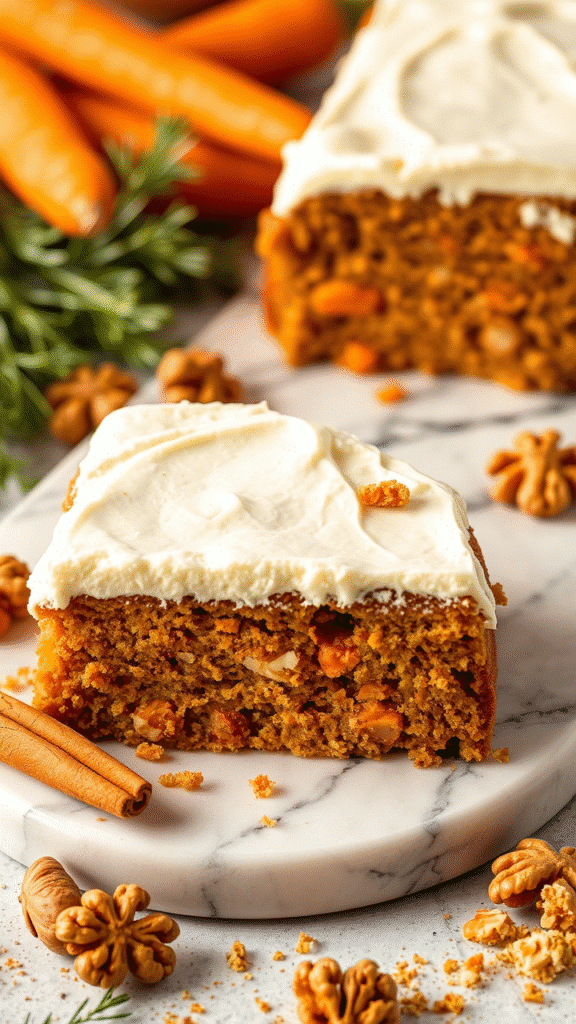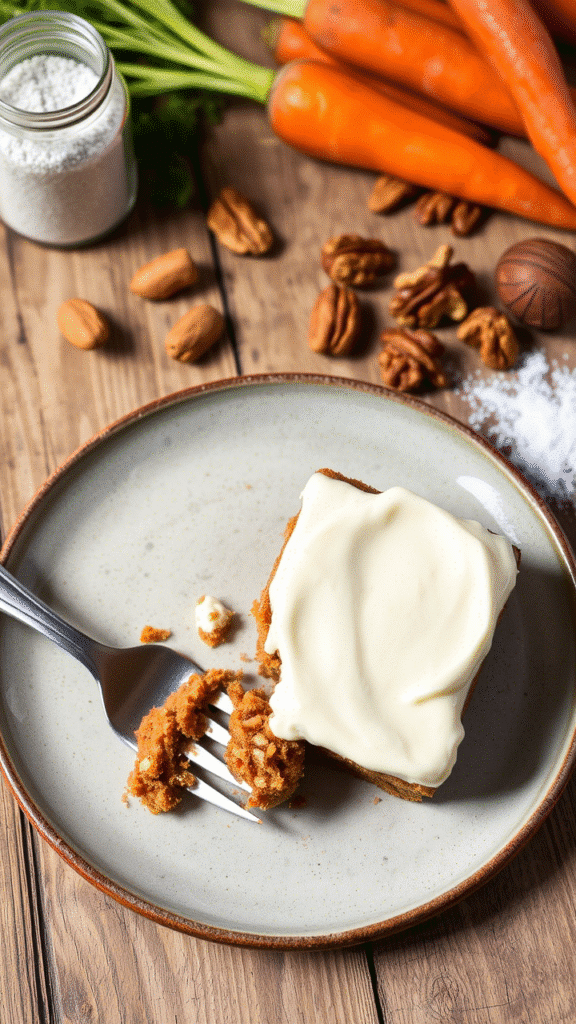Last Tuesday, I watched a seasoned pastry chef at Le Bernardin nearly throw away an entire batch of carrot cake because it “wasn’t worth serving.” The layers had collapsed, the frosting was grainy, and the carrots were stringy classic amateur mistakes that even experienced bakers fall into. That moment reminded me why mastering carrot cake bars is such a crucial skill for any serious baker.
Carrot cake bars represent the perfect marriage of convenience and sophistication. Unlike their towering layer cake cousins, bars deliver consistent portions, easier storage, and foolproof serving critical factors in professional kitchens where efficiency meets excellence.
The magic lies in achieving that perfect balance: moist, spiced cake studded with tender carrots, topped with silky cream cheese frosting that doesn’t weep or separate. It’s deceptively simple, yet requires precise technique to execute flawlessly.
What Makes These Carrot Cake Bars Special
These aren’t your grandmother’s dense, oil-heavy carrot bars. This recipe employs a dual-fat system combining butter for flavor complexity with neutral oil for moisture retention. The result is a tender crumb that stays fresh for days without becoming soggy or dry.
The spice blend goes beyond basic cinnamon. We’re incorporating freshly grated nutmeg, cardamom, and a whisper of white pepper that adds depth without announcing itself. Most home bakers miss this nuance entirely.
The cream cheese frosting uses a stabilization technique borrowed from French buttercream methods. This prevents the all-too-common disaster of separated, soupy frosting that ruins an otherwise perfect batch.
Ingredients & Substitutions
For the Bars:
- 2 cups all-purpose flour (240g)
- 2 teaspoons baking soda
- 1 teaspoon kosher salt
- 2 teaspoons ground cinnamon
- 1 teaspoon freshly grated nutmeg
- ½ teaspoon ground cardamom
- ¼ teaspoon white pepper
- 1¼ cups granulated sugar (250g)
- ½ cup light brown sugar, packed (100g)
- 1 cup vegetable oil (240ml)
- ½ cup unsalted butter, melted and cooled (115g)
- 4 large eggs, room temperature
- 2 teaspoons vanilla extract
- 3 cups finely shredded carrots (about 1 pound)
- 1 cup chopped walnuts (optional)
For the Cream Cheese Frosting:
- 8 oz cream cheese, room temperature
- ½ cup unsalted butter, room temperature (115g)
- 4 cups powdered sugar, sifted (480g)
- 2 teaspoons vanilla extract
- ¼ teaspoon kosher salt
- 2 tablespoons heavy cream
Professional Substitution Notes
Flour selection matters more than most realize. All-purpose flour with 10-11% protein content creates the ideal texture cake flour makes these too delicate, while bread flour produces a tough crumb. King Arthur’s all-purpose is my go-to for consistent results.
For the carrots, hand-grating produces superior texture compared to food processors, which can create mushy pulp. Use large carrots rather than baby carrots—they contain less water and more concentrated flavor. If you must use pre-shredded carrots, squeeze them dry with paper towels first.
The dual-fat system isn’t optional for professional results. Vegetable oil keeps the bars moist for days, while butter provides flavor complexity that oil alone can’t achieve. Avoid substituting all butter the texture becomes too dense and the bars don’t keep as well.
Spice quality dramatically impacts the final product. Pre-ground spices lose potency quickly. Invest in whole nutmeg and a microplane grater freshly grated nutmeg has floral notes that disappear in jarred versions. The white pepper adds subtle heat without the visual specks of black pepper, maintaining the cake’s clean appearance.
Step-by-Step Instructions

Preparing the Pan and Oven
Preheat your oven to 350°F (175°C). Line a 13×9-inch metal pan with parchment paper, leaving overhang for easy removal. Metal pans conduct heat more evenly than glass for bars this isn’t negotiable if you want consistent results.
Lightly butter the parchment to prevent sticking. This extra step prevents the heartbreak of beautiful bars that tear during removal.
Mixing the Batter
Whisk together flour, baking soda, salt, and all spices in a medium bowl. The key is even distribution lumpy spice mixture creates uneven flavor pockets that scream amateur hour.
In a large bowl, whisk both sugars with the oil and melted butter until well combined. The mixture should look glossy, not separated. Add eggs one at a time, whisking thoroughly after each addition. This gradual incorporation prevents the batter from breaking.
Stir in vanilla extract, then fold in the dry ingredients just until combined. Overmixing develops gluten, creating tough bars that professional kitchens would never serve.
The Carrot Integration Technique
Here’s where most bakers go wrong they dump in wet carrots that release moisture during baking, creating soggy bottoms. Pat your shredded carrots with paper towels to remove excess moisture first.
Fold carrots into the batter gently but thoroughly. Every bite should contain carrots, but they shouldn’t clump together in pockets. Add walnuts at this stage if using, ensuring even distribution.
Baking to Perfection
Spread batter evenly in the prepared pan use an offset spatula for professional-level smoothness. Bake for 35-40 minutes, until a toothpick inserted in the center comes out with just a few moist crumbs.
The top should spring back lightly when touched, and the edges should just begin pulling away from the pan sides. Overbaking creates dry bars that no amount of frosting can save.
Cool completely in the pan before frosting this takes patience, but warm bars will melt your frosting into a disaster.
Mastering the Cream Cheese Frosting
Room temperature ingredients are non-negotiable. Cold cream cheese creates lumps that never fully smooth out, while overly warm ingredients cause separation. Test by pressing—properly tempered cream cheese yields to gentle pressure without feeling soft or oily.
Beat cream cheese and butter together until completely smooth, about 3 minutes on medium speed. Scrape down the bowl frequently to ensure even mixing.
The Stabilization Secret
Add powdered sugar gradually, one cup at a time, beating on low speed to prevent sugar clouds. Once incorporated, increase to medium-high speed and beat for 2 minutes until fluffy.
Here’s the professional technique most miss: add vanilla, salt, and heavy cream, then beat on high speed for exactly 30 seconds. This brief high-speed beating creates the silky texture that separates professional frosting from amateur attempts.
Cooking Techniques & Science
The dual-fat system works because different fats behave differently during baking. Butter provides flavor compounds and structure through its milk solids, while oil coats flour proteins more effectively, preventing tough textures.

Baking soda rather than baking powder creates the proper rise and tender crumb. The acidic environment from brown sugar and the slight acidity in carrots activates the soda perfectly. Using baking powder instead creates a different texture that’s more cake-like and less suited to bar format.
The spice blend requires understanding volatile compounds. Cinnamon’s cinnamaldehyde provides warmth, nutmeg’s myristicin adds complexity, while cardamom’s terpenes brighten the overall flavor profile. White pepper’s piperine adds heat without visual interference a technique borrowed from classical French cooking.
Temperature control during mixing prevents gluten development. Cold ingredients shock flour proteins, while overly warm fats can cause separation. Room temperature ingredients blend smoothly without overworking.
Serving & Pairing Suggestions
Cut bars with a sharp, clean knife, wiping between cuts for professional presentation. A thin-bladed knife works better than serrated for clean edges through the frosting layer.
For elegant service, dust lightly with cinnamon or garnish with toasted walnut pieces. In restaurant settings, I often add a small candied carrot curl for visual impact.
These bars pair beautifully with coffee service the spices complement espresso’s bitter notes while the cream cheese frosting provides rich contrast. For wine service, consider late-harvest Riesling or vintage Port.
Store covered at room temperature for up to 3 days, or refrigerated for up to a week. The flavors actually improve after the first day as spices meld and moisture distributes evenly.
Advanced Variations
For upscale presentation, consider individual portions baked in mini loaf pans. Adjust baking time to 22-25 minutes for smaller formats.
A brown butter variation elevates the flavor profile significantly. Brown ½ cup of the butter until nutty and golden, then cool completely before incorporating. This adds depth that sophisticated palates appreciate.
For gluten-free service, substitute with a blend of almond flour (1 cup) and gluten-free flour blend (1 cup). Add ¼ teaspoon xanthan gum if your blend doesn’t include it.
Professional Storage and Service Tips

These bars freeze exceptionally well unfrosted. Wrap tightly in plastic wrap, then foil, for up to 3 months. Thaw completely before frosting.
For catering, frost the bars in the pan and cut just before service to maintain clean edges. The frosting holds well at room temperature for several hours without weeping.
In professional kitchens, I batch the dry ingredients ahead and store in labeled containers. This streamlines production during busy periods.
Conclusion
Mastering carrot cake bars requires understanding the science behind each component while maintaining the rustic charm that makes them beloved. The dual-fat system, proper spice integration, and stabilized frosting separate professional results from amateur attempts.
The beauty lies in their versatility equally at home in a casual café or upscale restaurant dessert menu. They scale beautifully for large events while maintaining individual portion control that customers appreciate.
Remember that excellence in baking comes from respecting each ingredient’s properties and understanding how they interact. These aren’t just carrot cake bars they’re a demonstration of technical skill disguised as comfort food.
Practice the techniques until they become second nature. Your consistency will build the reputation that separates true professionals from weekend bakers.
Frequently Asked Questions?
Q: Why do my carrot cake bars always turn out dense and heavy?
A: Dense bars typically result from overmixing the batter once flour is added, or using too much flour. Measure flour by weight (240g for 2 cups) rather than volume for accuracy. Mix just until ingredients combine lumps are better than tough bars. Also ensure your baking soda is fresh (replace every 6 months) as expired leavening creates dense textures.
Q: My cream cheese frosting always turns out lumpy or separates. What’s going wrong?
A: Temperature is everything with cream cheese frosting. Both cream cheese and butter must be at true room temperature (about 68°F) this takes 2-3 hours out of the refrigerator. Cold ingredients create lumps, while overly warm ingredients cause separation. Beat the cream cheese and butter thoroughly before adding any other ingredients, and add powdered sugar gradually to prevent shocking the mixture.
Q: How can I prevent my bars from being too oily or wet on the bottom?
A: This usually happens when carrots release too much moisture during baking. Always pat shredded carrots dry with paper towels before folding into batter. Also ensure your oven temperature is accurate too low heat causes bars to steam rather than bake properly. Use a metal pan rather than glass for better heat conduction, and avoid opening the oven door during the first 30 minutes of baking.
Q: Can I make these bars ahead for events, and how should I store them?
A: Carrot cake bars actually improve in flavor after 24 hours as spices meld and moisture distributes evenly. Store unfrosted bars wrapped tightly at room temperature for up to 2 days, or freeze for up to 3 months. Frost the day of serving for best appearance. Once frosted, store covered at room temperature for up to 3 days, or refrigerated for up to a week just bring to room temperature before serving for optimal texture.
Q: What’s the best way to achieve consistent, professional-looking portions?
A: Use a ruler to mark cutting lines before making cuts 9 cuts lengthwise and 6 cuts crosswise yields 63 perfect bars for catering. Clean your knife blade between cuts to prevent frosting buildup that creates ragged edges. For the cleanest cuts, chill the frosted bars for 30 minutes before cutting, then bring portions to room temperature before serving.

Veronica is a passionate food enthusiast with over three years of experience in exploring and writing about diverse cuisines. Her expertise lies in reviewing restaurants, sharing creative recipes, and discovering the latest food trends. As the voice behind FoodieRecap.com, Anju brings fresh perspectives and culinary insights to her audience.
